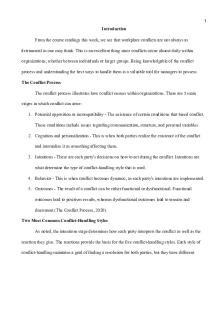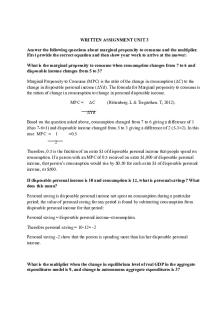BUS 5113- Organizational Theory and Behavior - Written Assignment Unit 1 #3 PDF

| Title | BUS 5113- Organizational Theory and Behavior - Written Assignment Unit 1 #3 |
|---|---|
| Author | Howard Khan |
| Course | Organizational Theory and Behavior |
| Institution | University of the People |
| Pages | 6 |
| File Size | 118.1 KB |
| File Type | |
| Total Downloads | 80 |
| Total Views | 160 |
Summary
Download BUS 5113- Organizational Theory and Behavior - Written Assignment Unit 1 #3 PDF
Description
BUS 5113: Organizational Theory and Behavior – Written Assignment Unit 1
Organizational Theories Written Assignment Unit 1 Organizational Theory and Behavior Term 4 2020 BUS 5113 University of the People April 2020
BUS 5113: Organizational Theory and Behavior – Written Assignment Unit 1
Written Assignment
Submit a paper which is 2-3 pages in length (no more than 3-pages), exclusive of the reference page. Paper should be double spaced in Times New Roman font (or its equivalent) which is no greater than 12 points in size. The paper should cite at least two sources in APA format. One source can be your textbook.
In Chapter 2 of the Organizational Theory text we reviewed four theoretical contributions which are central to the understanding of today's Organizations. Offer a brief analysis of all four theoretical concepts and then pick the one you the feel is the most influential from both historical and managerial perspectives. Explain. Now, consider how these concepts impacted the development of the current organizational theories.
Be sure to use APA formatting in your paper. Purdue University’s Online Writing LAB (OWL) is a free website that provides excellent information and resources for understanding and using the APA format and style. The OWL website can be accessed here: http://owl.english.purdue.edu/owl/resource/560/01/
Papers will be assessed using this rubric. Please review the rubric to be clear on the assessment criteria.
BUS 5113: Organizational Theory and Behavior – Written Assignment Unit 1
Every few hundred years, the world goes through a massive transformation that changes the way things operate. One of the recent transformations was the industrial revolution and how it established the concepts of mass production and organizations as we know it. Naturally, there was a need to create systems regarding the workings within organizations to ensure cohesiveness among employees and high productivity levels. As Jeffrey Pfeffer summarized in New Directions for Organization Theory, organizational theory studies provide "an interdisciplinary focus on a) the effect of social organizations on the behavior and attitudes of individuals within them, b) the effects of individual characteristics and action on organization,'¦ c) the performance, success, and survival of organizations, d) the mutual effects of environments, including resource and task, political, and cultural environments on organizations and vice versa, and e) concerns with both the epistemology and methodology that undergird research on each of these topics." And just like any principle, there are various theories towards how it should be implemented in a fashion that result in maximum efficiency. Hence, the different kinds of organizational theories. In this assignment, we’ll discuss four of the different theories with a main focus on task performance and structure which are:
Taylor – Scientific Management
Fayol – Administrative Theory
Weber - Bureaucracy and Organizational Structure
Simon – Administrative Behavior
BUS 5113: Organizational Theory and Behavior – Written Assignment Unit 1
Scientific Management- [talorism] (Frederick Winslow Taylor) This theory emphasizes the importance of following a scientific approach leading to finding the “one best way” to accomplish any given task. It suggests that discovering the fastest and most efficient procedure for performing a job will result in improved efficiency and better workflow. However, this theory was criticized based on Taylor’s assumption that there’s only one best way to do things, that he disregarded the human factor and failed to value its contribution. Fayol – Administrative Theory Henry Fayol’s theory leaned towards simplifying how management should interact with staff through the application of a set of management principles that he discussed in his book ‘Industrial and General Management’. His studies focused on the importance of division of work (specialization) and authority of one superior that gives orders and subordinates must obey. Weber - Bureaucracy and Organizational Structure The bureaucratic management theory is one of the most well-known and applied theories all over the world until this very moment. The Bureaucracy theory is primarily based on a hierarchical system along with a clear definition of rules, procedures, and regulations to be implemented within the organization. While applying the Bureaucracy theory in an organization can promote predictability and structure, it can also bring exploitation of power, delay of business decisions, and lack of creativity to the workplace.
BUS 5113: Organizational Theory and Behavior – Written Assignment Unit 1
Simon – Administrative Behavior In this theory Herbert Simon shares his findings about how organizations function and criticizes the shortsighted perception of other theories where Simon proposed the term “the Administrative Man” to replace Taylor’s “Economic Man”. The Administrative man is more human in terms of acknowledging that he might not be aware of all his interest but is willing to seek the optimal ones. Now that we’ve briefly discussed the four theories and how they are applied in an organization, we can claim that the Bureaucracy theory has been by far the most influential theory both historically and managerial wise. In fact, Bureaucracy has emerged everywhere regardless of the nation’s type (developed or developing). Most aspects of life were influenced by Bureaucracy, social, political, and economic, to name a few. Even human behavior patterns were affected by Bureaucratic organizations to create a generation of rigid, order following employees. The tough criticism of old schools that focus on task performance and structure created the need for a more “open organization” models where flexibility and emphasis on human side of the organization. Within the new model, more attention is given to human relationships and employees happiness. Concepts like enhanced team cooperation, less tension, interactive techniques to resolve conflicts, and interpersonal competence is highly appreciated. In conclusion, old formal theories for managing organizations lays important foundations that can be used for years to come while establishing new concepts and applications that are more applicable to the forever changing work environments.
BUS 5113: Organizational Theory and Behavior – Written Assignment Unit 1
References: Akindele, S. T., Afolabi, Y. A., Pitan, O. O., & Gidado, T. O. (2016). The threads of organizational theory: A phenomenological analysis. Management, 6(5), 158-184. Organization Theory. (-0001, November 30). Retrieved June 24, 2020, from https://www.inc.com/encyclopedia/organization-theory.html Laegaard, J. & Bindslev, M. (2006). Organizational theory, 1st ed. Ventus Publishing & Bookboon.com. The Mind Tools Content Team By the Mind Tools Content Team, Team, T., Wrote, Y., Wrote, B., & Wrote, A. (n.d.). Frederick Taylor and Scientific Management: Understanding Taylorism and Early Management Theory. Retrieved June 24, 2020, from https://www.mindtools.com/pages/article/newTMM_Taylor.htm M, P. (2020, March 07). Max Weber Bureaucracy Theory - Definition, Advantages, Disadvantages. Retrieved June 24, 2020, from https://theinvestorsbook.com/maxwebers-bureaucracy-theory.html (n.d.). Retrieved June 24, 2020, from http://faculty.babson.edu/krollag/org_site/encyclop/simon.html...
Similar Free PDFs

BUS 5113 Portfolio Unit 3 Answer
- 5 Pages

BUS 5113 - Unit 6 Discussion
- 4 Pages

BUS 5113 - Unit 5 Discussion
- 3 Pages

Written Assignment Unit 3
- 4 Pages

Written Assignment unit 3
- 2 Pages

Written Assignment Unit 3
- 2 Pages

BUS 5113 Discussion Unit 7
- 3 Pages

Written Assignment Unit 1
- 3 Pages
Popular Institutions
- Tinajero National High School - Annex
- Politeknik Caltex Riau
- Yokohama City University
- SGT University
- University of Al-Qadisiyah
- Divine Word College of Vigan
- Techniek College Rotterdam
- Universidade de Santiago
- Universiti Teknologi MARA Cawangan Johor Kampus Pasir Gudang
- Poltekkes Kemenkes Yogyakarta
- Baguio City National High School
- Colegio san marcos
- preparatoria uno
- Centro de Bachillerato Tecnológico Industrial y de Servicios No. 107
- Dalian Maritime University
- Quang Trung Secondary School
- Colegio Tecnológico en Informática
- Corporación Regional de Educación Superior
- Grupo CEDVA
- Dar Al Uloom University
- Centro de Estudios Preuniversitarios de la Universidad Nacional de Ingeniería
- 上智大学
- Aakash International School, Nuna Majara
- San Felipe Neri Catholic School
- Kang Chiao International School - New Taipei City
- Misamis Occidental National High School
- Institución Educativa Escuela Normal Juan Ladrilleros
- Kolehiyo ng Pantukan
- Batanes State College
- Instituto Continental
- Sekolah Menengah Kejuruan Kesehatan Kaltara (Tarakan)
- Colegio de La Inmaculada Concepcion - Cebu







